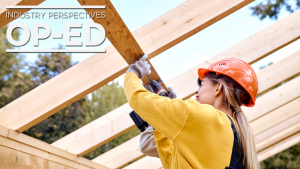Getting women into the construction trades hasn’t been an easy task, and the latest numbers from the Ontario College of Trades (OCOT) suggest there’s lots of room to grow.
As it stands, some 13 per cent of the College’s total membership are women but that is skewed because of trades such as hairdressing which primarily attracts women.
Drill deeper and only 1.2 per cent of the total members in the ICI trades are women, according to OCOT.
The top five ICI trades with OCOT members are, in order: electrician, general carpenter, plumber, industrial mechanic millwright and sheet metal worker.
That’s not for want of trying, but construction trades are not always at the top of many women’s career choices — until they realize their earning power and benefits, especially if they come in as a union apprentice.
“The College has been proactively promoting diversity in the trades,” says OCOT CEO and registrar, George Gritziotis.
“In part, that’s due to the increased need for skilled workers in the province because of retirements, but also because of the gender discrepancy in the skilled trades in the province. Engaging youth in discussions about the potential and rewards of the skilled trades as a stable and rewarding career path needs to start at an early age.”
It is all the more pressing, he says, with more than 20 per cent of the labour force set to retire over the next decade.
As such, the OCOT invests in promoting the concept of trades as a career with parents and educators but it is an uphill battle, more so recently because of the realization that a university degree doesn’t guarantee a good job and the trades have gained a toe hold as an option across the board.
If getting young men to look at trades and convincing their parents it is a good option, getting that message across to women is still a challenge.
“Guiding women into the trades will be an important part of replenishing our future workforce,” says Gritziotis.
However, as women do enter the construction sector there is a more ominous side.
Some women, particularly those who work in all-male sites, are reluctant to draw attention to their special needs
— Ontario Women’s Directorate
Jobsites can be dangerous places and because the data sample of women in construction is so small, there’s been little information about whether women face any unique risks male workers don’t.
Industry data, for example, suggests young workers and new workers in construction have a higher risk of injury in the workplace. That’s also shifting as the labour force ages with more workers 55 to 64 also suffering more injuries, according to at least one 2016 Alberta report.
However, there’s scant details about women in construction and injuries, mostly because the data is so thin. While young males often exhibit risky behaviour, misjudging jumps, not tying off, or being oblivious, there’s no data yet to suggest women are more cautious, more likely to follow the rules and more aware given that construction is a novel environment for most of them.
The Ontario Women’s Directorate, however, has flagged some concerns, specifically around personal protective equipment (PPE).
PPE is often designed for men and often doesn’t fit women properly.
“In many cases, women requiring PPE are forced to ‘make do’ and wear equipment designed for men,” the report noted. “Some women, particularly those who work in all-male sites, are reluctant to draw attention to their special needs.”
This includes gloves, goggles, helmets and even work boots, though specially designed boots for women are now widely available from Moxie Trades, an Ontario company selling through many retail locations.
Clarice Crocker, vice-president and treasurer of the Canadian Association of Women in Construction (CAWIC), says their research has turned up similar issues.
A report entitled Level Best, a three-year research project by CAWIC for Status of Women Canada, delivered in early 2017, looked at the challenges faced by women entering the trades as well as why they didn’t seem interested in that path.
“PPE was one of the issues, though I never had that issue myself working for 11 years on sites,” says Crocker. “But some of the more petite women did because often the equipment is too big.”
However, there were other myths the report dismissed, such as women’s physical strength versus men.
“A pervasive notion exists that physical strength is a requirement in certain types of careers,” the report found.
“These ideas often suggest that women are incapable of taking up roles such as construction workers.”
However, she says, a report on women in construction, filed with the Quebec parliamentary commission on gender equality in 2011, found 20 per cent of women are stronger than 50 per cent of men.
“There are weak women and strong men but in between there are women who are stronger and men who are weaker,” she says.
One of the big issues dissuading women from construction trades is that they anticipate workplace harassment, according to the report.
“Every site and crew are different and a lot of the culture onsite is set by the site superintendant,” she says.
Some crews like women members because there’s more attention to detail generally. In other crews, the more important work sometimes gets assigned to men while women can find themselves on the broom, frustrated they aren’t getting more challenging jobs. But, again, it varies according to experts.
Pregnancy is one area where women can’t avoid being treated differently onsite.
“Having just gone through a pregnancy and working up to my sixth month, I didn’t want to be seen as a burden,” she says.
“The two site superintendents in charge of the high-rise I was working on at the time assured me that adjusting tasks was a very simple process for them. They accommodated the scenario of a pregnant site member with great professionalism. It is living proof that site superintendents have an incredible amount of power to make a difference in the construction industry, notably in the ICI sector where women’s participation is incredibly low” .
The United States’ Occupational Safety and Health Administration (OSHA) adds their own issue, that of hydration on the job for women.
Dehydrated workers are more likely to make mistakes as their thought processes slow and their reaction times are also affected.
However, the OSHA notes, sanitation facilities often fall short on construction sites in that they are unisex and used mostly by men who aren’t always accurate with their aim.
The result is portable toilets that are “over-used and ill-maintained.” Because of this, OSHA finds, female workers tend to avoid both drinking water and using the facilities as much as possible.
“This results in multiple problems,” the OSHA says.
“For one, a worker who isn’t properly hydrated, especially in hotter months, risks a higher potential for heat-related illness. Secondly, a worker who is not using sanitation facilities as often as might be necessary, risks possible bladder and kidney infections. Additionally, facilities that aren’t properly maintained put all workers at higher risk of disease.”











I enjoyed this article and I am glad this topic is coming to the forefront. I have worked in the construction industry for 30 years, mostly on the estimating and project managing end but for the last 10 years I’ve been doing a lot of site supervision. I worked mostly in the Maritimes but did one call centre fit-up in Windsor Ontario. I have noticed a big change in the attitude towards women in the industry through more acceptance of equality. But that can be said in life in general. Yes there is much room for improvement but it is getting better. I totally agree with the fact that manufactures of PPE and clothing in general is not geared for women working in this industry or probably other industries. I find myself buying men’s clothing i.e. pants, jackets, socks etc. mainly for pockets, larger sizes and warmth. I totally agree, washroom facilities can be an issue also, but as the super on the job I have more control over that, they are still not set up for females i.e. porta potties. Sanitary disposal, hand-washing urinals in your face when you sit down, heat in some case you may have to almost totally undress to use the facilities in winter. Here, there are not a lot of women working in the trades so I have found that I haven’t wanted to express particular issues especially in the past. I have always worked for general contractors so I’ve had to deal with different trades and attitudes over the years and yes you need thick skin, this industry is it not touchy-feely but not as harsh as it once was.
I have been a welder for 25 years and now I am a Welding Professor for a community college. I do not find that women want to come into these fields because some of them fear losing their femininity.